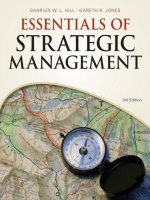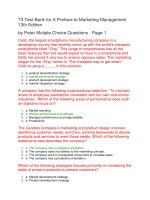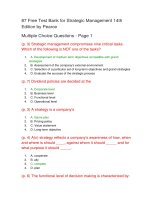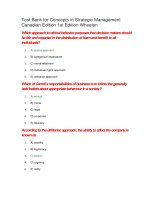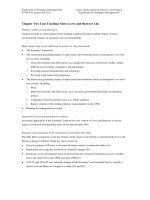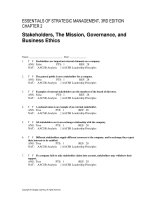Fred r david – strategic management, 13th edition ch08
Bạn đang xem bản rút gọn của tài liệu. Xem và tải ngay bản đầy đủ của tài liệu tại đây (87.62 KB, 34 trang )
Exam
Name___________________________________
TRUE/FALSE. Write 'T' if the statement is true and 'F' if the statement is false.
1)
Effective strategy formulation can usually guarantee successful strategy implementation.
1)
_______
2)
Strategy formulation is the managing of forces during the action, whereas strategy implementation is the
positioning of forces before the action.
2)
_______
3)
Strategy formulation requires coordination among a few individuals, but strategy implementation requires
coordination among many.
3)
_______
4)
It is always easier to say you are going to do something (strategy formulation) than to actually do it
(strategy implementation).
4)
_______
5)
Unlike strategy formulation, strategy implementation varies considerably among different types and sizes
of organizations.
5)
_______
6)
A bottom-up flow of communication is essential for developing top-down support.
6)
_______
7)
Annual objectives are key components in the strategic-management process because they dictate how
resources will be allocated.
7)
_______
8)
Horizontal consistency is more important than vertical consistency in developing annual objectives.
8)
_______
9)
Undesirable conduct such as distorting the record can be a result of overemphasis on achieving objectives.
9)
_______
10)
Policies refer to specific guidelines, methods, procedures, rules, forms, and administrative practices
established to support and encourage work toward stated goals.
10)
______
11)
Strategies clarify what can and cannot be done in pursuit of an organization's objectives.
11)
______
12)
Not allocating resources according to the priorities indicated by approved objectives is detrimental to the
strategic-management process.
12)
______
13)
Four types of resources that can be used to achieve desired objectives are financial, physical, human and
technological.
13)
______
14)
Avoidance, infusion and confrontation are the classifications for the various approaches for minimizing and
resolving conflict.
14)
______
15)
Conflict of any kind is avoidable in organizations.
15)
______
16)
Concerning managing and resolving conflict, defusion includes such actions as ignoring the problem in the
hope that the conflict will resolve itself.
16)
______
17)
Holding a meeting at which conflicting parties present their views and work through their differences is
part of the defusion strategy of managing conflict.
17)
______
18)
Exchanging members of conflicting parties so each can gain an appreciation of the other's point of view
exemplifies a confrontation approach.
18)
______
19)
Medium-sized firms tend to be divisionally structured, whereas large firms tend to use an SBU (strategic
business unit) or matrix structure.
19)
______
20)
Tasks and activities are grouped together by business function in a divisional organizational structure.
20)
______
21)
A functional structure can be effective at limiting short-term and narrow thinking.
21)
______
22)
Most large companies have abandoned the functional structure in favor of decentralization.
22)
______
23)
With a divisional structure, it is possible that competition between divisions may become so intense that it
leads to the improved sharing of ideas and resources for the common good of the firm.
23)
______
24)
When an organization has a divisional structure by customer, it can effectively cater to the requirements of
clearly defined customer groups.
24)
______
25)
Because activities are organized according to the way work is actually performed, a divisional structure by
process is similar to the matrix structure.
25)
______
26)
The most complex of all designs is a matrix structure.
26)
______
27)
With the matrix structure it is common for functional resources to be duplicated.
27)
______
28)
When developing an organizational chart, the top executive of the firm should be reserved for the
President.
28)
______
29)
When developing an organizational chart, it is not wise to recommend a dual title for just one executive.
29)
______
30)
In developing an organizational chart, avoid having a particular person reporting to more than one person
above them in the chain of command.
30)
______
31)
Restructuring is also called rightsizing.
31)
______
32)
In terms of number of employees, restructuring usually involves increasing the size of the firm.
32)
______
33)
Reengineering does not usually affect the organizational structure or chart, nor does it imply job loss or
employee layoffs.
33)
______
34)
Six Sigma is generally equally successful in retail firms and manufacturing firms.
34)
______
35)
The focus of restructuring is changing the way work is actually carried out.
35)
______
36)
Cornerstones of reengineering are decentralization, reciprocal interdependence and information sharing.
36)
______
37)
An effective bonus system should be based on two key factors annual objectives and long-term objectives.
37)
______
38)
People's anxieties are raised with the thought of change because they fear economic loss, inconvenience,
uncertainty and a break in normal social patterns.
38)
______
39)
Resistance to change can be considered the single greatest threat to successful strategy implementation.
39)
______
40)
A rational change strategy means giving orders and enforcing those orders.
40)
______
41)
Ideally, the rational type change strategy is the most desirable.
41)
______
42)
The fastest of all approaches to implement change is the rational change strategy.
42)
______
43)
The rational change strategy is one that presents information to convince people of the need for change.
43)
______
44)
Recently, an increasing number of companies have been implementing less rigorous environmental
policies.
44)
______
45)
Managing as if the earth matters requires an understanding of how international trade, competitiveness
and global resources are connected.
45)
______
46)
Managing environmental affairs is primarily a technical function performed by specialists in a firm.
46)
______
47)
Production processes typically constitute less than 50 percent of a firm's total assets.
47)
______
48)
JIT significantly increases the costs of implementing strategies.
48)
______
49)
Besides reducing worker alienation and stimulating productivity, employee stock-ownership plans allow
firms other benefits, such as substantial depreciation savings.
49)
______
50)
ESOPs work well even in firms with fluctuating payrolls and profits.
50)
______
51)
Work/family issues are typically focused on the benefit to working women.
51)
______
52)
In recent years, powerful Arab businesswomen have made their mark on the international scene.
52)
______
MULTIPLE CHOICE. Choose the one alternative that best completes the statement or answers
the question.
53)
Strategy formulation
53)
______
A)
focuses on effectiveness.
B)
is primarily an operational process.
C)
requires coordination among many people.
D)
is managing forces during the action.
E)
all of the above
54)
Which of these is true about strategy implementation?
54)
______
A)
It is primarily an operational process.
B)
It focuses on effectiveness.
C)
It is primarily an intellectual process.
D)
It is positioning forces before the action.
E)
It requires intuitive skills.
55)
How are objectives in the areas of profitability, growth and market share commonly established?
55)
______
A)
Geographic location
B)
Customer groups
C)
Business segment
D)
Product
E)
all of the above
56)
Establishing objectives is a
56)
______
A)
top-level activity.
B)
command-and-control activity.
C)
centralized activity.
D)
decentralized activity.
E)
centralized-decentralized activity.
57)
Considerable time and effort should be devoted to assuring objectives are well conceived because they
represent the basis for
57)
______
A)
establishing divisional priorities.
B)
monitoring processes.
C)
evaluating managers.
D)
allocating resources.
E)
all of the above
58)
Which of the following is not true about objectives?
58)
______
A)
They should be measurable.
B)
They should be communicated throughout the organization.
C)
They should have an appropriate time dimension.
D)
They should incorporate policies.
E)
They should be consistent.
59)
Which term would most likely be incorporated into written objective statements?
59)
______
A)
all of the above
B)
Maximize
C)
Adequate
D)
10% increase
E)
Minimize
60)
What are guidelines, methods, procedures, rules, forms and administrative practices known as?
60)
______
A)
Strategies
B)
Annual objectives
C)
Long-term objectives
D)
Goals
E)
Policies
61)
Which of the following issues may not require a management policy?
61)
______
A)
To increase motivation
B)
To establish a high- or low-safety stock of inventory
C)
To discourage insider trading
D)
To offer numerous or few employee benefits
E)
To promote from within to or to hire from the outside
62)
Which term is best defined as a central management activity that allows for strategy execution?
62)
______
A)
Conflict
B)
Establishing annual objectives
C)
Policy-making
D)
Goal-setting
E)
Resource allocation
63)
________ is not a major factor in prohibiting effective resource allocation.
63)
______
A)
Vague strategy targets
B)
Lack of sufficient knowledge
C)
Reluctance to take risks
D)
Underprotection of resources
E)
Organizational politics
64)
A disagreement between two or more parties on one or more issues is called a(n)
64)
______
A)
compromise.
B)
diffusion.
C)
conflict.
D)
integrated solution.
E)
avoidance.
65)
Conflict in an organization is
65)
______
A)
always bad.
B)
sometimes good and sometimes bad.
C)
avoidable.
D)
a sign of bankruptcy.
E)
always good.
66)
What are three categories for approaches to managing and resolving conflict?
66)
______
A)
Avoidance, defusion and confrontation
B)
Avoidance, payoff and defusion
C)
There are no good ways to manage conflict.
D)
Confrontation, ignorance and objectivity
E)
Buy, sell and hold
67)
Which approach for managing and resolving conflict involves exchanging members of conflicting parties of
that each can gain an appreciation of the others point of view?
67)
______
A)
Resistance
B)
Avoidance
C)
Defusion
D)
Compliance
E)
Confrontation
68)
Which approach for managing and resolving conflict involves ignoring the problem in hopes that the
conflict will resolve itself?
68)
______
A)
Compliance
B)
Avoidance
C)
Resistance
D)
Confrontation
E)
Defusion
69)
Which approach for managing and resolving conflict involves playing down differences between conflicting
parties while accentuating similarities and common interests?
69)
______
A)
Avoidance
B)
Defusion
C)
Resistance
D)
Confrontation
E)
Compliance
70)
Why do changes in company strategy often require changes in the way an organization is structured?
70)
______
A)
Structure dictates authority over projects.
B)
Structure dictates strategy.
C)
Structure dictates how resources will be obtained.
D)
Structure dictates how goals and objectives will be established.
E)
Structure dictates how money is spent.
71)
What type of organizational structure do most small businesses follow?
71)
______
A)
Divisional structure by customer
B)
Functional structure
C)
Process type structure
D)
Divisional structure by product
E)
Matrix structure
72)
Which organizational structure is the most simple and inexpensive?
72)
______
A)
Departmental
B)
Decentralized
C)
Functional
D)
Strategic business unit
E)
Process
73)
Medium-sized firms are more likely to use which type of structure?
73)
______
A)
Matrix
B)
Functional
C)
Divisional
D)
SBU
E)
Process
74)
What is not one of the basic ways a divisional structure can be organized?
74)
______
A)
By product or service
B)
By cost
C)
By customer
D)
By process
E)
By geographic area
75)
A divisional structure by product is most effective when
75)
______
A)
special emphasis needs to be placed on specific products.
B)
an organization's products or services differ substantially.
C)
an organization offers few products.
D)
special emphasis needs to be placed on specific services.
E)
all of the above
76)
How would Hershey's current divisional structure most likely be classified?
76)
______
A)
By geographic area
B)
By service
C)
By customer
D)
By product
E)
By process
77)
A divisional structure by geographic area is most appropriate when
77)
______
A)
strict control and attention to product lines are needed.
B)
an organization offers only a limited number of products or services.
C)
organizations have similar branch facilities located in widely dispersed areas.
D)
an organization has many skilled managers.
E)
the firm serves one geographic area.
78)
What is the best divisional structure when a few major customers are of paramount importance and many
different services are provided to these customers?
78)
______
A)
By customer
B)
By cost
C)
By product
D)
By geographic area
E)
By process
79)
Which organizational structure has ambiguous roles for senior executives as a major disadvantage?
79)
______
A)
Strategic business unit (SBU)
B)
Functional
C)
Matrix
D)
Divisional
E)
Process
80)
What is the most complex form of organizational structure?
80)
______
A)
Divisional
B)
Matrix
Geographic
C)
D)
Functional
E)
Strategic business unit (SBU)
81)
When developing an organizational chart, you should
81)
______
A)
Make sure that the chief financial officer is not at the same level as the chief operating officer.
B)
Use the title "president" for the top person.
C)
Have division presidents report to a chief operating officer.
D)
Recommend dual titles for executives.
E)
Have the controller or treasurer report directly to the president.
82)
Restructuring is also referred to as
82)
______
A)
integrating.
B)
job security.
C)
starting over.
D)
diversifying.
E)
delayering.
83)
Which term is most often associated primarily with shareholder well-being rather than employee wellbeing?
83)
______
A)
Restructuring
B)
Reengineering
C)
Benchmarking
D)
Process management
E)
Product redesign
84)
Which of these involves comparing a firm against the best firms in the industry on a wide variety of
performance-related criteria?
84)
______
A)
Process redesign
B)
Benchmarking
C)
Reengineering
D)
Restructuring
E)
Delayering
85)
The primary benefit sought from restructuring is
85)
______
A)
increased number of hierarchical levels in the organization.
B)
increased innovation.
C)
increased morale.
D)
employee involvement.
E)
cost reduction.
86)
What action involves reconfiguring or redesigning work, jobs and processes for the purpose of improving
costs, quality, service and speed?
86)
______
A)
Reengineering
B)
Downsizing
C)
Restructuring
D)
Delayering
E)
Benchmarking
87)
A firm uses information technology to break down functional barriers and to create a work system based
on business processes, products, or outputs rather than on functions or inputs in
87)
______
A)
restructuring.
B)
benchmarking.
C)
reengineering.
D)
delayering.
E)
decentralization.
88)
Which pay strategy is not a form of incentive compensation?
88)
______
A)
Bonus system
B)
Hourly wage
C)
Profit sharing
D)
All of these are forms of incentive compensation.
E)
Gain sharing
89)
Which of these is not one of the tests used to determine whether a performance-pay plan will benefit an
organization?
89)
______
A)
Does the plan pay out when it should?
B)
Do employees understand the plan?
C)
Does the plan reduce management layers?
D)
Does the plan capture attention?
E)
Is the plan improving communications?
90)
What change strategy involves giving orders and enforcing those orders?
90)
______
A)
Self-interest
B)
Educative
C)
Rational
D)
Defusion
Force
E)
91)
Resistance to change can manifest itself through
91)
______
A)
sabotaging production machines.
B)
unwillingness to cooperate.
C)
absenteeism.
D)
filing unfounded grievances.
E)
all of the above
92)
A change strategy that attempts to convince people that the planned change is to their personal
advantage is
92)
______
A)
diffusion.
B)
force.
C)
compromise.
D)
rational.
E)
educative.
93)
What challenge facing all organizations requires managers to formulate strategies that preserve and
conserve natural resources and control pollution?
93)
______
A)
Economic
B)
Benchmarking
C)
Global
D)
Compensational
E)
Ecological
94)
Just-in-time describes
94)
______
A)
a scheduling method for meetings.
B)
a personnel planning method.
C)
implementing strategies just before bankruptcy.
D)
delivering materials just as they are needed.
E)
a process for improving quality.
95)
A concern in matching managers with strategy is that jobs have relatively ________ responsibilities, while
people are ________ in their development.
95)
______
A)
quick; slow
B)
exciting; dull
C)
dynamic; static
D)
static; dynamic
E)
dull; exciting
96)
There are now several Arab companies with female CEOs, some of which have appeared in Forbes' list of
96)
______
A)
the 500 Most Powerful Women in the World.
B)
the 100 Most Powerful Women in the World.
C)
the 1000 Most Powerful Women in the World.
D)
the 10 Most Powerful Women in the World.
E)
the 50 Most Powerful Women in the World.
97)
In 2007, ________ organized a special interactive event to raise awareness on work/life balance issues in
the UAE.
97)
______
A)
the Dubai Executive Council
B)
the Dubai Race Club
C)
the Dubai World
D)
the Dubai Knowledge Village
E)
the Dubai Economic Department
98)
Among the Arab states, there is ________ awareness of the need to balance work and family affairs.
98)
______
A)
stable
B)
decresing
C)
reducing
D)
